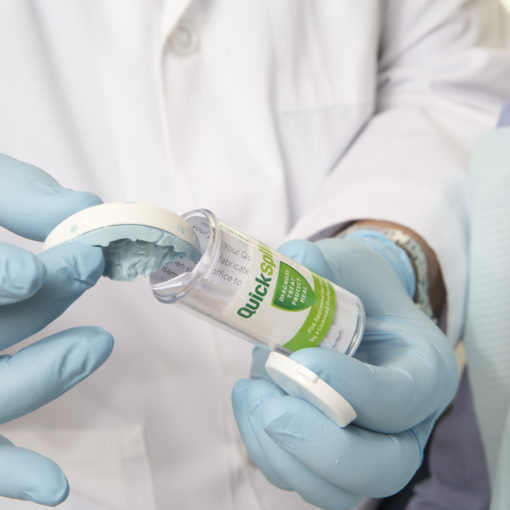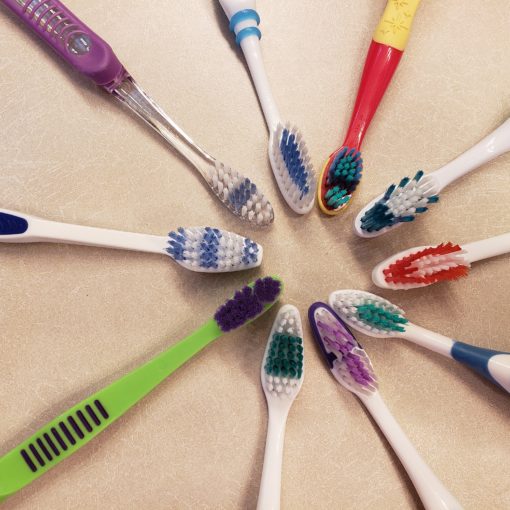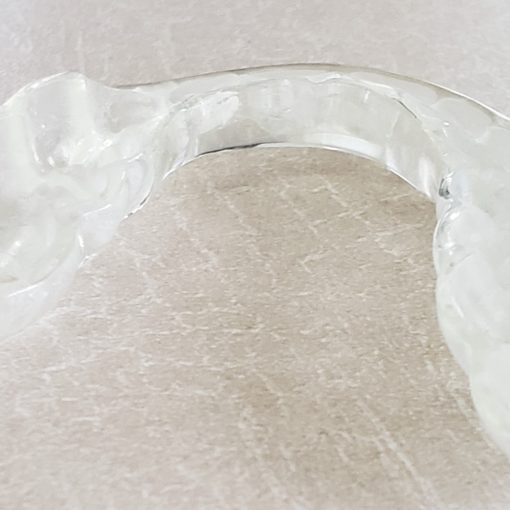WHITENING PRODUCTS
The reason for whitening is all cosmetic. It’s removing discoloration and stain from the teeth making the teeth whiter and brighter. Since it’s considered cosmetic insurance won’t pay for any whitening procedures. Reasons whitening is so popular is that it promotes confidence, self-esteem, a younger appearance, cleaner looking teeth—by reducing daily stains. A popular time when people tend to want to whiten their teeth is when participating in special events such as reunions, weddings, graduations, ceremonies—usually occasions when several pictures will be taken. Also, when getting a new restoration on a front tooth, instead of having a darker restoration, people will whiten their teeth to have a lighter more appealing filling or crown.
There are a variety of whitening products in the dental aisle of the stores including: mouthwash, toothpaste, white strips and trays. Whitening products only whiten natural teeth. While whitening has been around for a while, it’s only become more popular in the last 15-20 years. A burst of all kinds of whitening treatments have surfaced in the last decade. Keep in mind there haven’t been years of research with monitored affects with the whitening products to determine any future risks. Technically, use of whitening products have increased in the last two decades, which isn’t a lot of time to determine any long-term effects within the mouth. As with most products, use it in moderation and follow the instructions. Pregnant or nursing moms should be cautious as research hasn’t proven whitening to be safe nor harmful.
Whitening works by drying the teeth out to promote enamel porosity for the whitening product to absorb into the tooth. As of now there aren’t many side effects that have surfaced, except sensitivity and gum irritation. If you tend to have sensitive teeth, use the whitening product for a lesser time than instructed until the teeth are acclimated to it. Using a desensitizing toothpaste a few weeks prior to starting the whitening treatment and continue during the treatment and afterwards, as needed , will lessen the occurrence of sensitivity. For best results as all whitening products will state, refrain from staining producing products. Coffee, tea, dark juices, soda, red wine, blueberries and smoking are common stain instigators. Using both whitening products and staining agents can be counterproductive. Results are dependent of tooth shade, habits and diet. Yellow teeth will get the best results, whereas brown and grayish teeth will get lesser results if any at all.
Mouth wash
Whitening mouthwashes will usually include the ingredient hydrogen peroxide for the whitening agent. Swish with the rinse for 60 seconds twice a day. This process could take 12 weeks for minimal results due to it not being on the teeth for a long amount of time.
Toothpaste
Whitening toothpastes are mild abrasives and are intended to help remove surface stains. For a subtle whitening to help prevent stains from forming, some toothpastes contain gentle polishing agents to be more effective with stain removal. These toothpastes can minimally lighten the shade of the teeth by one shade. Yellow colored teeth tend to get better results.
Whitening Strips
Whitening strips are a very thin, clear strip coated with a peroxide base gel. These strips cover the front of the front teeth only, usually the front four to six teeth. The back teeth are not affected, but they are usually not seen anyways. Initial results are seen in a few days while final results are sustained for about four months. They’re convenient to wear and you can still talk, work, walk and drink water.Follow the instructions for best results.
A tip to consider: Place the bottom strip first then place the top strip. The foaming action of the strip increases salivation and if the top strip is applied first the increased flow of saliva makes it more difficult for the bottom strip to adhere to the teeth.
For the most part, white strips are recommended to wear for 30 minutes, one time a day.
Gels
Whitening gels are clear and use a peroxide base which is applied by brushing onto the teeth. This product is beneficial for touch ups. Initial results are seen in a few days while the final results are sustained for about four months. Follow the instructions for best results. Some gel products are recommended to store in the refrigerator.
Trays
In the dental office there is a whitening kit of disposable strips, called Opalescence. This kit includes a higher percentage of whitening concentrate peroxide then what is sold on the stores shelves. It looks like a tray but it’s really a strip with gel. The tray is placed in the mouth, then suck it up to get a fit and remove the tray and the whitening strip sticks. Leave on for an hour, one time a day. This product has a desensitizing ingredient to aid in any sensitivity.
Professional whitening trays usually sent to a lab, although some offices make them in-office. These trays are usually an upfront cost. Gel is acquired when needed for whitening. Use the gel sparsely, since a little goes a long way. Apply the gel to the tooth slot in the tray that you want whitened. So if a crown is on a front tooth, there’s no need to waste gel there, since it won’t change the crown color. Depending on your smile, depends how many teeth need whitened. If your smile exposes only the six front teeth or all the way to your molars you can adjust how many teeth to use the gel on.
Pens
Whitening pens are commonly used for “touch-ups” after previously whitening and in addition used for full whitening. There’s multiple brands with different agents and percentages of whitening ingredients. Most pens use hydrogen peroxide, as it produces significantly faster results than carbamide peroxide. Simply “paint” the front surfaces of the teeth with the gel, while smiling, to ensure all the teeth in the smile line are included. The viscosity of the gel enables it to remain in contact with the tooth surface long enough to soak into the enamel and whiten the teeth. Most brands will recommend applying the whitening gel twice daily for two weeks straight. Most whitening pens will hold enough gel for 30-60 applications.
Professional Whitening
Professional whitening or in-office whitening have quicker results. Costs tend to be more expensive with chair time lasting one to two hours.
WHITENING TRAYS
Whitening trays or custom-made trays are a two-appointment process. After taking impressions of the teeth they are sent to a dental lab. It usually takes a couple of weeks to process the trays. The second appointment will be to pick up the trays after making sure they fit well. With these personal home-used trays, whitening gel is inserted into the teeth slots. This method of whitening is convenient and more controlled. If some teeth have fillings or crowns, that tooth spot can be spared of gel, since it won’t do any good. Plus, the amount of gel used for whitening can be discretionary. The whitening gel is a higher concentration of whitening ingredients, therefore only able to buy in the dental office.
LASER
This in-office method uses a laser to whiten teeth quickly and achieve multiple shades of whitening, with instant results. The laser light activates the whitening gel that is placed on the teeth. This method usually takes a few hours. This process is a higher risk of sensitivity due to the quick, intense and multiple shade change.
Whitening Ingredients
Peroxide
Peroxide is the active ingredient in nearly all tooth whitening products. The two types of peroxides are carbamide and hydrogen. Peroxides dehydrate the enamel structure and creates a chemical reaction by destroying the chromospheres in the pigments that stain the teeth. This ingredient breaks down allowing oxygen into the enamel of the teeth, resulting in bleached teeth. Products will contain different strengths of peroxide. Carbamide is usually a higher percentage than hydrogen peroxide and breaks down to a 3:1 ratio making a 10% percent of carbamide peroxide is equal to 3% hydrogen peroxide, other common doses are 22 % carbamide peroxide is about 7.5% hydrogen peroxide. Stronger products produce faster results and increases chance of sensitivity. Whereas, lower amounts will take longer to whiten and carry less of a risk for sensitivity. Chemical destruction and dehydration are the irritating effects of this process causing noticeable symptoms to extreme sensitivity.
Different whitening ingredients are used depending on the product
Carbamide Peroxide
Carbamide peroxide is hydrogen peroxide combined with urea. Tooth whitening products with this ingredient typically range from concentrations of 10% to 22%. Carbamide peroxide numbers are higher than hydrogen peroxide products due to it breaking down into hydrogen peroxide. Compared to hydrogen peroxide , carbamide has a longer shelf life.
Used in: Professional tooth whitening formulas, teeth bleaching gels, light-activated tooth whitening gels and some whitening toothpastes.
Hydrogen Peroxide
Hydrogen Peroxide is the active tooth whitening ingredient in it’s basic form.
Used in: Whitening strips, paint on whiteners, whitening mouth rinses
Calprox
Calprox is a newer patented formula which consists of baking soda and is a proprietary form of calcium peroxide. The baking soda freshens the breath and the calcium helps strengthen and re-mineralize the enamel. This product works by dissolving the protein pellicle — a thin, clear layer of protein which forms on the teeth. Plaque, food, bacteria and stains will bind with the pellicle and cause discoloration and plaque on the teeth. Calprox diffuses this pellicle layer to prevent stains and whitens teeth.
Used in: Whitening toothpastes
Polyvinylprrolidone (PVP)
Is an adhesion to prevent new stains from adhering to the teeth.
Used in: Whitening strips and whitening toothpastes
Baking Soda
Baking soda cleans, freshens the breath and neutralizes the acid in the mouth. It is a mild abrasive used to remove stain.
Used in: Whitening toothpastes
Sodium tripolyphosphate
Acts as a detergent to help remove stains from the teeth.
Used in: Whitening toothpastes
Hydrated Silica
Formed from silicon dioxide and is a mild abrasive in cleaning stains from the teeth.
Used in: Whitening toothpastes
Carbomer
Enhances whitening results.





